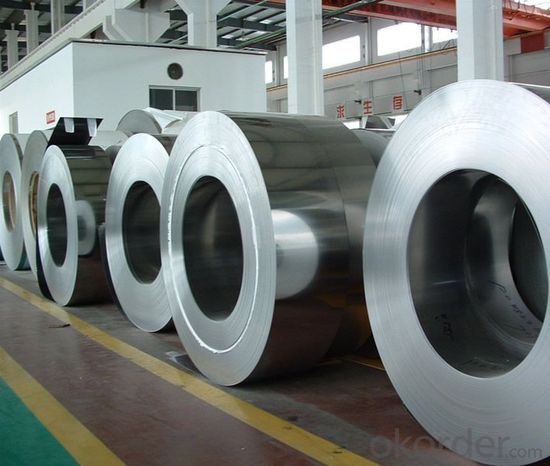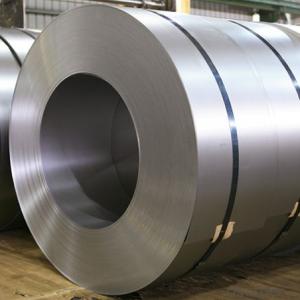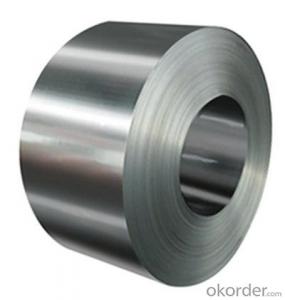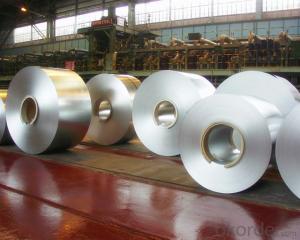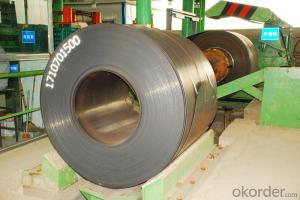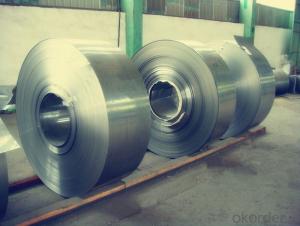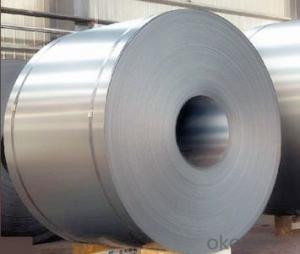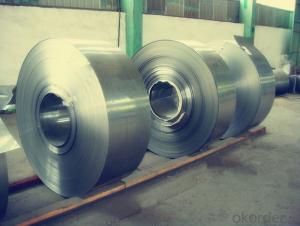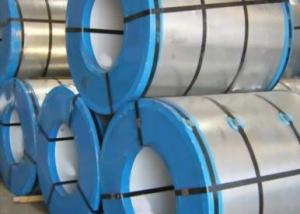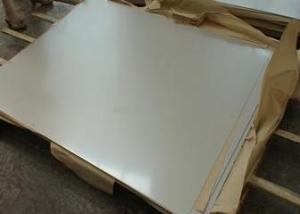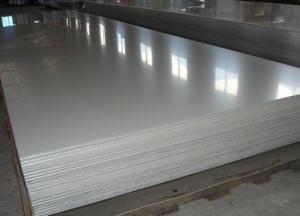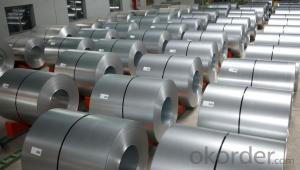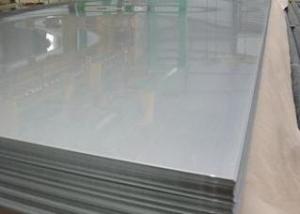Hot Rolled Stainless Steel Coil 201
- Loading Port:
- Qingdao
- Payment Terms:
- TT OR LC
- Min Order Qty:
- -
- Supply Capability:
- 5000 m.t./month
OKorder Service Pledge
OKorder Financial Service
You Might Also Like
Hot Rolled Stainless Steel Coil 201
Stainless steel is a production which not easy rust,acid resistance and corrosion resistance,so it is widely
used in light industry,heavy industry,daily necessities and the decoration industry.my company long-term
supply stainless steel porducts including:stainless steel sheet,stainless steel coil and stainless steel tube.
Grade: | 200 Series | Standard: | JIS,AISI,ASTM,GB,DIN | Thickness: | 2.5/3.0/4.0mm |
Width: | 485/510/550/610/1010/1240mm | Place of Origin: | Shanghai China (Mainland) | Brand Name: | CNBM |
Model Number: | 201 | Technique: | Hot Rolled | Application: | Industrial tubes/kitchen/bath |
Certification: | ISO | THK: | 2.5/3.0/4.0mm | Face: | No.1 |
Usage: | tubes/kitchen/bath | Origin: | CHINA | ||
Hot Stainless Steel Coil 201 grade, Chemical Composition(WT%)
(C):≤0.15, (Si):≤0.75, (Mn):5.5~7.50, (Cr):16.0~18.0, (N):≤0.25, (Ni):3.50~5.50, (P):≤0.060, (S):≤0.030
Hot Rolled Stainless Steel Coil 201 Grade
Strength Of Extension:100,000 To 180,000 Psi;
Yield Strength:50,000 To 150,000 Psi
Elongation :55 To 60%;
Modulus Of Elasticity:29,000,000 Psi;
Density :.280lbs/Cubic Inch(7.93g/Cm3)
- Q: What are the different grades of stainless steel used for strips?
- The different grades of stainless steel used for strips can vary depending on the specific application and requirements. Some commonly used grades include 304, 316, 430, and 201. Each grade has its own unique properties and characteristics, such as corrosion resistance, strength, and heat resistance. The selection of the grade depends on factors like the environment, load-bearing capacity, aesthetic appeal, and cost considerations.
- Q: What are the different types of edges available for stainless steel strips?
- There are several different types of edges available for stainless steel strips, depending on the specific application and desired appearance. Some common types of edges include: 1. Mill Edge: This is the standard edge produced during the manufacturing process. It has a smooth, straight finish with no additional processing or treatment. 2. Slit Edge: This edge is created by cutting the stainless steel strip to the desired width using a slitting machine. It typically has a slight burr or roughness along the edge, which can be removed through deburring or other finishing processes. 3. Rounded Edge: Also known as a round edge or rolled edge, this type of edge is created by rolling the stainless steel strip to give it a curved or rounded profile. It provides a safer and more comfortable edge, making it suitable for applications where sharp edges could pose a risk. 4. Deburred Edge: This edge is achieved by removing any burrs or roughness from the edge of the stainless steel strip. Deburring is typically done using specialized equipment or processes to ensure a smooth and clean finish. 5. Beveled Edge: A beveled edge is created by cutting the stainless steel strip at an angle, usually 45 degrees, to create a sloping or chamfered edge. This type of edge is often used for aesthetic purposes or to facilitate welding or joining of the strips. 6. Custom Edges: Depending on the specific requirements of a project or application, custom edges can also be created. These may include different profiles, finishes, or treatments to meet specific functional or aesthetic needs. It is important to consider the intended use and requirements of the stainless steel strips when selecting the appropriate edge type. The choice of edge can impact the performance, appearance, and safety of the final product.
- Q: Where can stainless steel strips be purchased?
- There are multiple places where you can obtain stainless steel strips. One possibility is to go to local hardware stores or specialty metal suppliers that have a wide selection of stainless steel products. These establishments usually have various sizes and grades of stainless steel strips ready for purchase. Another option is to use online retailers and e-commerce websites, which offer a convenient way to buy stainless steel strips. Platforms like Amazon, eBay, or Alibaba have many sellers that provide stainless steel strips in different dimensions and quantities. However, it is crucial to make sure that the seller has a good reputation and provides accurate product descriptions to guarantee the quality and suitability of the stainless steel strips you are buying.
- Q: Are stainless steel strips suitable for dairy tanks?
- Yes, stainless steel strips are suitable for dairy tanks. Stainless steel is a popular choice for dairy tanks due to its excellent corrosion resistance, hygienic properties, and ease of cleaning. It is also resistant to bacterial growth and does not react with milk or other dairy products, making it a safe and reliable material for dairy tank construction.
- Q: What are the factors affecting the electrical resistivity of 111 stainless steel strips?
- The factors affecting the electrical resistivity of 111 stainless steel strips include the composition and purity of the stainless steel, temperature, and the presence of impurities or defects within the material. Additionally, the grain structure and crystallographic orientation of the stainless steel can also influence its electrical resistivity.
- Q: What are the different certifications and standards for stainless steel strips?
- There are several certifications and standards for stainless steel strips, including ASTM (American Society for Testing and Materials) standards, EN (European Norm) standards, and ISO (International Organization for Standardization) certifications. These standards and certifications ensure that stainless steel strips meet specific requirements for composition, mechanical properties, and performance, ensuring their quality and suitability for various applications.
- Q: What are the common uses of stainless steel strips in the automotive suspension systems?
- Various purposes necessitate the common usage of stainless steel strips in automotive suspension systems. One of the primary applications lies in the manufacturing of leaf springs, which form an integral part of said suspension system. Leaf springs possess the responsibility of absorbing shocks and preserving the stability of the vehicle. Stainless steel strips offer ideal material qualities for leaf springs, including excellent durability, resistance to corrosion, and high tensile strength. Moreover, the production of coil springs heavily relies on the utilization of stainless steel strips. Coil springs play a crucial role in supporting the vehicle's weight and providing a smooth ride. Stainless steel's exceptional strength-to-weight ratio enables the creation of lightweight coil springs capable of withstanding heavy loads and maintaining their shape over time. Additionally, sway bars or stabilizer bars are fabricated using stainless steel strips. These bars are responsible for minimizing body roll and enhancing the vehicle's handling during cornering. The exceptional strength and resistance to deformation exhibited by stainless steel make it a suitable material for sway bars, thus ensuring optimal performance and longevity. Furthermore, suspension brackets, hangers, and other components that necessitate high strength and resistance to corrosion find application of stainless steel strips. These components are vital for maintaining the structural integrity of the suspension system and ensuring the safe operation of the vehicle. In conclusion, the exceptional mechanical properties, corrosion resistance, and durability of stainless steel strips make them widely employed in automotive suspension systems. They play a vital role in enhancing the performance, stability, and safety of vehicles on the road.
- Q: Are stainless steel strips suitable for laser cutting?
- Yes, stainless steel strips are suitable for laser cutting. Laser cutting is a highly precise and efficient method of cutting various materials, including stainless steel. The high energy density of the laser beam allows for a clean and accurate cut, without causing any distortion or damage to the metal. Stainless steel, known for its corrosion resistance and durability, is a popular material choice for many industries, including automotive, aerospace, and construction. Laser cutting offers several advantages for stainless steel strips, such as reducing material waste, maintaining tight tolerances, and enabling intricate designs. Additionally, laser cutting provides a smooth and burr-free edge finish, enhancing the aesthetic appeal of the stainless steel strips.
- Q: Can stainless steel strips be used in the production of HVAC grilles?
- Indeed, HVAC grilles can incorporate stainless steel strips. The durability, corrosion resistance, and aesthetic appeal of stainless steel make it a favored material for HVAC grilles. By utilizing stainless steel strips in the production process, the grilles can endure the rigorous conditions of heating, ventilation, and air conditioning systems without succumbing to rust or deterioration over time. Moreover, stainless steel strips provide a sleek and contemporary look, making them an excellent selection for architectural and design purposes. In summary, stainless steel strips present a fitting and dependable choice for manufacturing HVAC grilles.
- Q: How do stainless steel strips perform in high temperature environments?
- Stainless steel strips are renowned for their exceptional performance in environments with high temperatures. Their outstanding resistance to oxidation and scaling at elevated temperatures is a result of their inherent properties. This can be mainly attributed to the presence of chromium in the steel, which creates a protective oxide layer on the surface when exposed to air, thereby preventing further corrosion. In high temperature environments, stainless steel strips maintain their strength and integrity, rendering them suitable for a wide array of applications. They can endure thermal cycling without significant degradation, ensuring long-term performance and dependability. Furthermore, stainless steel strips exhibit favorable mechanical properties at elevated temperatures, including high tensile and creep strength. This makes them highly desirable for applications involving both high temperatures and mechanical stresses, such as in heat exchangers, furnaces, and automotive components. Moreover, stainless steel strips possess exceptional thermal conductivity, enabling efficient heat transfer and distribution. This is particularly crucial in high temperature environments, as it aids in maintaining consistent temperatures and preventing the occurrence of hot spots or thermal stress. Overall, stainless steel strips have consistently demonstrated their reliability and durability in high temperature environments. Their resistance to corrosion, mechanical strength, and thermal conductivity make them a popular choice across a variety of industries, guaranteeing optimal performance and longevity even under extreme conditions.
Send your message to us
Hot Rolled Stainless Steel Coil 201
- Loading Port:
- Qingdao
- Payment Terms:
- TT OR LC
- Min Order Qty:
- -
- Supply Capability:
- 5000 m.t./month
OKorder Service Pledge
OKorder Financial Service
Similar products
Hot products
Hot Searches
Related keywords







